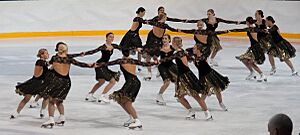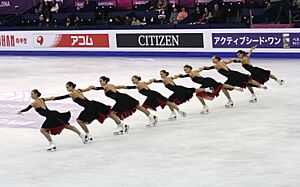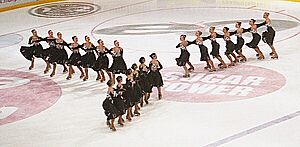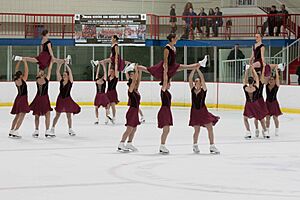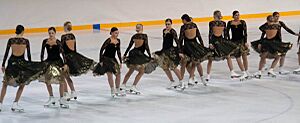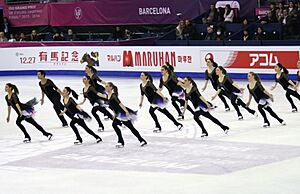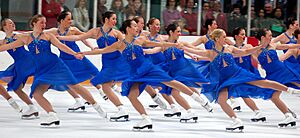Synchronized skating facts for kids

Team Paradise at the 2015 Grand Prix
|
|
| Highest governing body | International Skating Union |
|---|---|
| Nicknames | "precision skating", "synchro" |
| First Performed | 1956 |
| Characteristics | |
| Team members |
|
| Mixed-sex | Mixed |
| Type |
|
| Equipment |
|
| Venue |
|
| Presence | |
| Olympic | No |
| Paralympic | No |
| World Games | No |
Synchronized skating, often called synchro, is an ice skating sport. It involves 8 to 20 skaters performing together as a team. They glide over the ice at high speed. They perform cool moves and footwork all at once.
This sport started in 1956. It was first called "precision skating." This was because teams had to make exact shapes and move perfectly together. Synchronized skating is now a big sport in many countries. Many European teams win international championships. In 2022, there were over 600 synchro teams in the United States alone.
Contents
How Synchronized Skating Works
Synchronized skating is judged like other figure skating events. Judges look at how well skaters move. They also check their transitions, performance, and how hard their moves are.
A synchronized skating program has many parts. Teams make different shapes on the ice. These include blocks, triangles, circles, lines, or wheels. They move across the ice and spin. Teams must also do turns and step sequences. These moves can be easy or very hard.
There are many levels in synchro. These include Beginner, Intermediate, Novice, Junior, and Senior. Junior and Senior teams are the highest levels. They perform two programs. One is a short program. The other is a longer free skate. The short program shows off technical skills. The free skate lets teams show their feelings and creativity.
Junior teams compete at the ISU World Junior Synchronized Skating Championships. Senior teams compete at the ISU World Synchronized Skating Championships. Countries can send one team to each level. Countries that finished in the top five last year can send two teams.
Judges give points for each move. They also take points away for mistakes. For example, if many skaters make a mistake on a move, points are lost. Falls, interruptions, or breaking rules also lead to deductions.
History of Synchronized Skating
The first synchronized skating team started in 1956. Dr. Richard Porter formed the 'Hockettes' in Ann Arbor, Michigan. They entertained crowds during hockey games. Early precision skating looked like a drill team or dance group. In 1974, the first rulebook for judges was made.
The sport grew in the 1970s. Teams became more creative. They added harder skating skills and new moves. The first international competition was in 1976. It was held in Michigan between Canadian and American teams. As the sport grew worldwide, it became faster. Teams also started adding jumps, spirals, spins, and lifts. These moves were not allowed at first.
Cool Moves and Shapes
Synchro programs include many different moves and shapes. Each move gets a score based on how hard it is. Judges also give points for how well it is done. The harder a move is, the more points it can get. Teams can earn levels from Basic to Level 4 (most difficult).
Team Formations
Teams make specific shapes on the ice. Sometimes they change from one shape to another. This makes the move harder and earns more points.
Block
A block is when skaters line up in at least three rows. They form shapes like squares or diamonds. These shapes can be solid or have an empty space in the middle.
Circle
A circle is when skaters spin around a center point. They stay an equal distance from the middle and from each other. Circles can be connected or separate. Teams can make many circles or circles inside other circles. To make it harder, they can change places or weave. They can also change how they spin.
Line
Lines are important for many moves. They show how well the team skates together. Lines are also used to build blocks and wheels. Lines can be connected or separate.
Wheel
A wheel is when all skaters spin around a center point. They are connected in lines, like spokes on a wheel. Teams can make wheels with two to five spokes. Each spoke should be straight. Skaters should lean into the center of the wheel. Adding footwork or changing spin direction makes the wheel harder.
Special Elements
Programs have a certain number of special moves. This number changes each season. Junior and Senior teams do 5 elements in the short program. Junior teams do 8 elements in the free skate. Senior teams do 10.
Artistic Element
This move is done in a circle, wheel, line, or block. It helps show the music or theme of the program. It does not need special steps or changes of place.
Group Lift Element
In this move, all team members are involved. Skaters form groups. One skater is lifted by two or more teammates. Lifts can be gliding or spinning.
Intersection Element
An intersection is when skaters skate towards each other in lines. They then cross through each other. Intersections can have two to four lines. Three and four-line intersections form triangles or boxes. Skaters can do turns or other moves as they cross. This makes the intersection harder.
Mixed Element
This move has at least two different shapes happening at the same time. For example, a circle inside a wheel, or a line crossing a block.
No Hold Element
In this move, skaters are in a block shape but are not holding hands. They keep even space while doing steps and changing their formation.
Pair Element
All team members work in pairs. They do pairs moves, free skating moves, or step sequences together.
Synchronized Spin Element
All team members spin at the same time. They can spin alone or in pairs. They stay in a clear shape on the ice. All skaters do the same spin position. They move from one position to another as a team.
Twizzle Element
This move focuses on the twizzle turn. The team does two or three twizzles. They can be in any clear shape. Skaters must keep their shape or change it while twizzling. They also spin at the same time. To make it harder, they can change places or do different arm and leg positions.
Big Competitions
There are international synchronized skating competitions. These are for Senior, Junior, and Novice levels. Senior is the top level. The International Skating Union held the first official ISU World Synchronized Skating Championships (WSSC) in 2000. It was in Minneapolis, USA.
The top Junior teams used to compete at the ISU Junior World Challenge Cup. This was from 2001 to 2012. In 2013, the ISU World Junior Synchronized Skating Championships started. It happens every two years. Other big international events include the French Cup and Spring Cup.
ISU World Synchronized Skating Championships
The ISU World Synchronized Skating Championships (WSSC) are the world championships for synchro. They happen every year since 2000. Teams from Finland and Sweden have won the most medals. Finland has three different World Champion teams. Sweden's Team Surprise has the most World titles for one team. Canada and the United States also have many medals.
| Year | Location | Gold | Silver | Bronze | Source |
| 2025 | |||||
| 2024 | |||||
| 2023 | |||||
| 2022 | |||||
| 2021 | Event cancelled | ||||
| 2020 | Event cancelled | ||||
| 2019 | |||||
| 2018 | |||||
| 2017 | |||||
| 2016 | |||||
| 2015 | |||||
| 2014 | |||||
| 2013 | |||||
| 2012 | |||||
| 2011 | |||||
| 2010 | |||||
| 2009 | |||||
| 2008 | |||||
| 2007 | |||||
| 2006 | |||||
| 2005 | |||||
| 2004 | |||||
| 2003 | |||||
| 2002 | |||||
| 2001 | |||||
| 2000 | |||||
ISU World Junior Synchronized Skating Championships
This competition is for junior-level teams. It is a big event where young skaters from around the world compete.
| Year | Location | Gold | Silver | Bronze | Source |
|---|---|---|---|---|---|
| 2024 | |||||
| 2023 | |||||
| 2022 | |||||
| 2021 | Event Cancelled | ||||
| 2020 | |||||
| 2019 | |||||
| 2018 | |||||
| 2017 | |||||
| 2015 | |||||
| 2013 | |||||
Synchronized Skating in the United States
In the United States, there are many different levels for synchro teams. These are set by the US Figure Skating Association. Some levels are for fun and don't go to Nationals. Other levels, like Juvenile, Intermediate, Novice, Junior, Senior, Collegiate, Adult, and Masters, can compete at the national championships.
Most skaters in synchronized skating are girls. However, the rules allow teams to have both boys and girls.
US Figure Skating Senior Championship
This is the top level for senior teams in the US. A team has 16 skaters. Skaters must be at least 15 years old.
| Year | Location | Gold | Score | Silver | Score | Bronze | Score | Pewter | Score | Source |
|---|---|---|---|---|---|---|---|---|---|---|
| 2020 | Providence, Rhode Island | Haydenettes | 203.19 | Skyliners | 194.94 | Crystallettes | 193.09 | Miami University | 192.39 | |
| 2019 | Plymouth, Michigan | Haydenettes | 226.37 | Skyliners | 218.14 | Crystallettes | 201.63 | Miami University | 196.95 | |
| 2018 | Portland, Oregon | Haydenettes | 204.05 | Skyliners | 185.86 | Miami University | 182.99 | Crystalettes | 166.89 | |
| 2017 | Rockford, Illinois | Haydenettes | 208.83 | Crystallettes | 189.50 | Skyliners | 172.96 | Miami University | 172.84 | |
| 2016 | Kalamazoo, Michigan | Haydenettes | 202.26 | Miami University | 183.86 | Skyliners | 169.47 | Crystallettes | 166.96 | |
| 2015 | Providence, Rhode Island | Haydenettes | 210.55 | Miami University | 194.70 | Skyliners | 178.99 | Crystallettes | 173.78 | |
| 2014 | Colorado Springs, Colorado | Haydenettes | 205.02 | Crystallettes | 179.77 | Starlights | 154.90 | Miami University | 149.64 | |
| 2013 | Plymouth, Michigan | Haydenettes | 206.33 | Miami University | 191.28 | Crystallettes | 176.96 | Skyliners | 151.56 | |
| 2012 | Worcester, Massachusetts | Haydenettes | 202.92 | Crystallettes | 185.54 | Miami University | 182.64 | ICE'Kateers | 145.15 | |
| 2011 | Ontario, California | Haydenettes | 217.41 | Miami University | 195.50 | Crystallettes | 179.85 | California Gold | ||
| 2010 | Minneapolis, Minnesota | Haydenettes | 231.14 | Crystallettes | 210.35 | Miami University | 202.68 | Starlights | 167.80 | |
| 2009 | Portland, Maine | Miami University | 204.72 | Haydenettes | 203.97 | Crystallettes | 184.10 | California Gold | ||
| 2008 | Providence, Rhode Island | Haydenettes | 213.37 | Miami University | 201.26 | Crystallettes | 184.10 | California Gold | ||
| 2007 | Colorado Springs, Colorado | Haydenettes | 201.04 | Miami University | 199.56 | Crystallettes | 159.65 | California Gold | 158.06 | |
| 2006 | Grand Rapids, Michigan | Miami University | 179.72 | Haydenettes | 161.28 | Crystallettes | 155.12 | Team Elan | 126.96 | |
| 2005 | Lowell, Massachusetts | Haydenettes | * | Miami University | * | Crystallettes | * | Team Elan | * | |
| 2004 | San Diego, California | Haydenettes | * | Crystallettes | * | Team Elan | * | Miami University | * | |
| 2003 | Huntsville, Alabama | Haydenettes | * | Miami University | * | Team Elan | * | Crystallettes | * | |
| 2002 | Lake Placid, New York | Haydenettes | * | Miami University | * | Crystallettes | * | |||
| 2001 | Colorado Springs, Colorado | Haydenettes | * | Miami University | * | Crystallettes | * | |||
| 2000 | Plymouth, Michigan | Haydenettes | * | Team Elan | * | Miami University | * | |||
| 1999 | Tampa, Florida | Miami University | * | Haydenettes | * | Starlets | ||||
| 1998 | San Diego, California | Haydenettes | Miami University | Team Elan | * | |||||
| 1997 | Syracuse, New York | Haydenettes | * | Team Elan | * | Miami University | * | |||
| 1996 | Chicago, Illinois | Haydenettes | * | Miami University | * | Team Elan | * | |||
| 1995 | San Diego, California | Team Elan | * | Haydenettes | * | Miami University | * | |||
| 1994 | Providence, Rhode Island | Haydenettes | * | Team Elan | * | Miami University | * | |||
| 1993 | Detroit, Michigan | Haydenettes | * | Team Elan | * | Crystallettes | * | |||
| 1992 | Portland, Maine | Haydenettes | * | Team Elan | * | Goldenettes | * | |||
| 1991 | Anchorage, Alaska | Haydenettes | * | Goldenettes | * | Fraserettes | * | |||
| 1990 | Houston, Texas | Goldenettes | * | Haydenettes | * | Fraserettes | * | |||
| 1989 | Providence, Rhode Island | Haydenettes | * | Goldenettes | * | Detroit Capets | * | |||
| 1988 | Reno, Nevada | Haydenettes | * | Fraserettes | * | Detroit Capets | * | |||
| 1987 | Tulsa, Oklahoma | Fraserettes | * | Haydenettes | * | Figurettes | * | |||
| 1986 | Boston, Massachusetts | Hot Fudge Sundaes | * | Haydenettes | * | Detroit Capets | * | |||
| 1985 | Lakewood, Ohio | Fraserettes | * | Ice Crystallettes | * | Minneapplettes | * | |||
| 1984 | Bowling Green, Ohio | Fraserettes | * | Ice Crystallettes | * | * |
USFSA Collegiate Championship
Collegiate teams have 12-20 skaters. These skaters must be full-time college students. Many colleges have synchro teams. Some are varsity sports, like at Miami University. Others are club teams, like at the University of Michigan. Miami University has been a leader in college synchro. They were the first to have a fully funded varsity program. They are also working to make synchro an NCAA sport in the US.
| Year | Location | Gold | Score | Silver | Score | Bronze | Score | Pewter | Score | Source |
|---|---|---|---|---|---|---|---|---|---|---|
| 2023 | Peoria, IL | Miami University | Univ of Michigan | Western Michigan | ||||||
| 2022 | Colorado Springs, CO | Miami University | 116.95 | Adrian College | 105.74 | Western Michigan | 104.30 | Univ of Michigan | 97.95 | |
| 2020 | Providence, RI | Univ of Michigan | 106.49 | |||||||
| 2019 | Plymouth, MI | Univ of Michigan | 91.67 | |||||||
| 2018 | Portland, OR | Univ of Michigan | 91.48 | |||||||
| 2017 | Rockford, IL | Univ of Michigan | 88.22 | |||||||
| 2016 | Kalamazoo, MI | Miami University | 90.12 | Univ of Michigan | 86.28 | Metroettes | 82.15 | |||
| 2015 | Providence, RI | Miami University | 94.12 | Univ of Michigan | 85.69 | Metroettes | 84.25 | |||
| 2014 | Colorado Springs, CO | Miami University | 96.80 | Team Excel | 78.77 | Michigan State | 78.60 | Univ of Michigan | ||
| 2013 | Plymouth, MI | Miami University | 92.26 | Univ of Delaware | 84.11 | Univ of Michigan | 77.98 | |||
| 2012 | Worcester, MA | Miami University | 87.80 | Univ of Delaware | 84.29 | Univ of Michigan | 80.83 | |||
| 2011 | Ontario, CA | Miami University | 96.16 | Michigan State | 85.17 | Univ of Michigan | 83.96 | |||
| 2010 | Minneapolis, MN | Miami University | 107.60 | Univ of Michigan | 98.46 | Univ of Delaware | 94.97 | |||
| 2009 | Portland, ME | Miami University | 100.63 | Univ of Illinois | 86.79 | Michigan State | 85.79 | |||
| 2008 | Providence, RI | Miami University | 107.46 | Univ of Delaware | 97.77 | Michigan State | 87.11 | Univ of Michigan | ||
| 2007 | Colorado Springs, CO | Miami University | 102.61 | Michigan State | 92.17 | Univ of Delaware | 88.74 | |||
| 2006 | Grand Rapids, MI | Miami University | Western Michigan | Univ of Delaware | ||||||
| 2005 | Lowell, MA | Miami University | Western Michigan | Michigan State | Univ of Michigan | |||||
| 2004 | San Diego, CA | Western Michigan | Miami University | Univ of Delaware | ||||||
| 2003 | Huntsville, AL | Miami University | Western Michigan | Univ of Michigan | Univ of Michigan | |||||
| 2002 | Lake Placid, NY | Miami University | Michigan State | Western Michigan | Univ of Michigan | |||||
| 2001 | Colorado Springs, CO | Miami University | Western Michigan | Michigan State | ||||||
| 2000 | Plymouth, MI | Miami University | Univ of Delaware | Univ of Michigan | ||||||
| 1999 | Tampa, FL | Univ of Michigan | Miami University | Univ of Delaware | ||||||
| 1998 | San Diego, CA | Miami University | Michigan State | Bowling Green | Univ of Michigan | |||||
| 1997 | Syracuse, NY | Miami University | Bowling Green | Western Michigan |
Synchronized Skating in Canada
The Canadian Synchronized Skating Championships are yearly events. They decide the national champions of Canada. They started in 1983. Since 2000, senior teams can qualify for the ISU World Synchronized Skating Championships here. Since 2023, Junior and Senior teams compete at the combined Canadian Figure Skating Championships.
The Future of Synchro
Why Not Synchro?
Synchronized skating is not yet an Olympic sport. But it has been considered for the Olympics. In 2007, it was a demonstration sport at the Universiade (World University Games). Teams from Sweden, Finland, and Russia won there.
"Why Not Synchro" is a campaign on social media. People use hashtags like #whynotsynchro to spread the word. This started at the Mozart Cup in 2014. Teams formed the shape of the Olympic rings on the ice. This picture was shared online. Skaters want to raise awareness for their sport. A petition asks the International Olympic Committee to make it an Olympic event.
How COVID-19 Affected Synchro
The COVID-19 pandemic cut the 2019–2020 season short. This was to keep everyone safe. Top US teams like the Haydenettes could not compete internationally. This was due to travel rules. The US Figure Skating Association works to keep athletes healthy.
How Judges Score Synchro
Competitive levels of synchronized skating use a special judging system. It is called the ISU Judging System. This system started in 2004. Experts decide how hard each move is. Each difficulty level has a certain point value. This is called the base value. Judges then add or subtract points based on how well the move was done. This is called the Grade of Execution (GOE). The best and worst GOE scores are removed. The rest are averaged. This average is added to the base value. All these scores together make the Technical Elements score.
Program Component Score
Judges also give points for the overall performance. They score from 0.25 to 10. The highest and lowest scores are removed. The rest are averaged. This score is then adjusted. This makes sure the technical score and performance score are balanced.
The main parts they score are:
- Skating Skills - How well skaters move on the ice. This includes steps, turns, and body control.
- Performance - How much skaters show their feelings. This depends on the music and program.
- Composition - How well the program is put together. This includes how moves are arranged and how they fit the music.
Technical Score
Every move in the program has a base value. Harder moves like spins and step sequences have different levels. Judges give a GOE score from -5 to +5 for each move. This score is added or taken away from the base value. The GOE is based on how well the move was done. The highest and lowest GOE scores are removed. The rest are averaged. This average is added to or taken away from the base value. All these scores together make the technical score.
Segment Score
The technical score and the program component score are added together. This gives the segment score. The scores from all parts of the competition are added up. The team with the highest total score wins. If there is a tie, the team with the higher free program score wins. This judging system is used in many competitions.
Older 6.0 System
Some beginner levels in the United States still use the 6.0 judging system. In this system, judges give scores out of 6.0. The team that most judges rank highest wins. These levels compete at regional events. They cannot go to national championships.
How Judging Systems Are Different
The new ISU Judging System gives points for every move. The old 6.0 system ranked teams. The new system focuses on each skater's performance. Judges do not have to compare all skaters at once. They just score each part of the performance.


